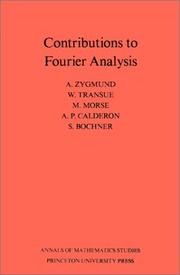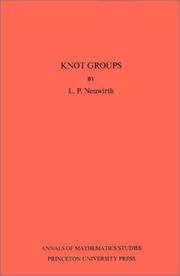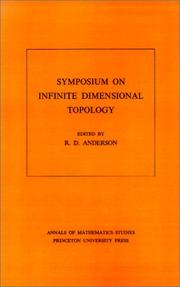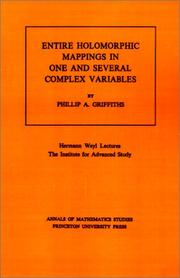| Listing 1 - 10 of 33 | << page >> |
Sort by
|

ISBN: 0691079307 1400881951 Year: 2016 Publisher: Princeton, NJ : Princeton University Press,
Abstract | Keywords | Export | Availability | Bookmark
 Loading...
Loading...Choose an application
- Reference Manager
- EndNote
- RefWorks (Direct export to RefWorks)
The description for this book, Contributions to Fourier Analysis. (AM-25), will be forthcoming.
Fourier analysis. --- Analysis, Fourier --- Mathematical analysis --- Absolute value. --- Almost periodic function. --- Approximation. --- Bessel function. --- Bilinear map. --- Boundary value problem. --- Characterization (mathematics). --- Coefficient. --- Compact space. --- Comparison theorem. --- Conservative vector field. --- Constant function. --- Continuous function. --- Corollary. --- Counterexample. --- Diagonalization. --- Diagram (category theory). --- Diameter. --- Dimension. --- Dirichlet kernel. --- Dirichlet problem. --- Dirichlet's principle. --- Distribution function. --- Exponential polynomial. --- Exponential sum. --- Fourier series. --- Fourier transform. --- Harmonic function. --- Hilbert space. --- Hölder's inequality. --- Integer. --- Interpolation theorem. --- Linear combination. --- Lp space. --- Measurable function. --- Measure (mathematics). --- Partial derivative. --- Partial differential equation. --- Periodic function. --- Poisson formula. --- Polynomial. --- Power series. --- Quantity. --- Rectangle. --- Remainder. --- Semicircle. --- Several complex variables. --- Sign (mathematics). --- Simple function. --- Special case. --- Sphere. --- Square root. --- Step function. --- Subsequence. --- Subset. --- Theorem. --- Theory. --- Triangle inequality. --- Two-dimensional space. --- Uniform continuity. --- Uniform convergence. --- Variable (mathematics). --- Vector field. --- Vector space.

ISBN: 0691079919 1400882036 9780691079912 Year: 1965 Volume: 56 Publisher: Princeton, N. J.
Abstract | Keywords | Export | Availability | Bookmark
 Loading...
Loading...Choose an application
- Reference Manager
- EndNote
- RefWorks (Direct export to RefWorks)
The description for this book, Knot Groups. Annals of Mathematics Studies. (AM-56), Volume 56, will be forthcoming.
Topology --- 512 --- Algebra --- 512 Algebra --- Knot theory. --- Knots (Topology) --- Low-dimensional topology --- Abelian group. --- Alexander duality. --- Alexander polynomial. --- Algebraic theory. --- Algorithm. --- Analytic continuation. --- Associative property. --- Automorphism. --- Axiom. --- Bijection. --- Binary relation. --- Calculation. --- Central series. --- Characterization (mathematics). --- Cobordism. --- Coefficient. --- Cohomology. --- Combinatorics. --- Commutator subgroup. --- Complete theory. --- Computation. --- Conjugacy class. --- Conjugate element (field theory). --- Connected space. --- Connectedness. --- Coprime integers. --- Coset. --- Covering space. --- Curve. --- Cyclic group. --- Dehn's lemma. --- Determinant. --- Diagonalization. --- Diagram (category theory). --- Dimension. --- Direct product. --- Equivalence class. --- Equivalence relation. --- Euclidean space. --- Euler characteristic. --- Existential quantification. --- Fiber bundle. --- Finite group. --- Finitely generated module. --- Frattini subgroup. --- Free abelian group. --- Fundamental group. --- Geometry. --- Group ring. --- Group theory. --- Group with operators. --- Hausdorff space. --- Homeomorphism. --- Homology (mathematics). --- Homomorphism. --- Homotopy group. --- Homotopy. --- Identity matrix. --- Inner automorphism. --- Interior (topology). --- Intersection number (graph theory). --- Knot group. --- Linear combination. --- Manifold. --- Mathematical induction. --- Monomorphism. --- Morphism. --- Morse theory. --- Natural transformation. --- Non-abelian group. --- Normal subgroup. --- Orientability. --- Permutation. --- Polynomial. --- Presentation of a group. --- Principal ideal domain. --- Principal ideal. --- Root of unity. --- Semigroup. --- Simplicial complex. --- Simply connected space. --- Special case. --- Square matrix. --- Subgroup. --- Subset. --- Summation. --- Theorem. --- Three-dimensional space (mathematics). --- Topological space. --- Topology. --- Torus knot. --- Transfinite number. --- Trefoil knot. --- Trichotomy (mathematics). --- Trivial group. --- Triviality (mathematics). --- Two-dimensional space. --- Unit vector. --- Wreath product.
Book
ISBN: 0691080917 1400881781 9780691080918 Year: 1971 Volume: 68 Publisher: Princeton, N.J.
Abstract | Keywords | Export | Availability | Bookmark
 Loading...
Loading...Choose an application
- Reference Manager
- EndNote
- RefWorks (Direct export to RefWorks)
Part exposition and part presentation of new results, this monograph deals with that area of mathematics which has both combinatorial group theory and mathematical logic in common. Its main topics are the word problem for groups, the conjugacy problem for groups, and the isomorphism problem for groups. The presentation depends on previous results of J. L. Britton, which, with other factual background, are treated in detail.
Group theory --- 510.6 --- Mathematical logic --- 510.6 Mathematical logic --- Group theory. --- Logic, Symbolic and mathematical. --- Groupes, Théorie des --- Groups, Theory of --- Substitutions (Mathematics) --- Algebra --- Algebra of logic --- Logic, Universal --- Symbolic and mathematical logic --- Symbolic logic --- Mathematics --- Algebra, Abstract --- Metamathematics --- Set theory --- Syllogism --- Abelian group. --- Betti number. --- Characteristic function (probability theory). --- Characterization (mathematics). --- Combinatorial group theory. --- Conjecture. --- Conjugacy class. --- Conjugacy problem. --- Contradiction. --- Corollary. --- Cyclic permutation. --- Decision problem. --- Diffeomorphism. --- Direct product. --- Direct proof. --- Effective method. --- Elementary class. --- Embedding. --- Enumeration. --- Epimorphism. --- Equation. --- Equivalence relation. --- Exact sequence. --- Existential quantification. --- Finite group. --- Finite set. --- Finitely generated group. --- Finitely presented. --- Free group. --- Free product. --- Fundamental group. --- Fundamental theorem. --- Group (mathematics). --- Gödel numbering. --- Homomorphism. --- Homotopy. --- Inner automorphism. --- Markov property. --- Mathematical logic. --- Mathematical proof. --- Mathematics. --- Monograph. --- Natural number. --- Nilpotent group. --- Normal subgroup. --- Notation. --- Permutation. --- Polycyclic group. --- Presentation of a group. --- Quotient group. --- Recursive set. --- Requirement. --- Residually finite group. --- Semigroup. --- Simple set. --- Simplicial complex. --- Solvable group. --- Statistical hypothesis testing. --- Subgroup. --- Theorem. --- Theory. --- Topology. --- Transitive relation. --- Triviality (mathematics). --- Truth table. --- Turing degree. --- Turing machine. --- Without loss of generality. --- Word problem (mathematics). --- Groupes, Théorie des --- Décidabilité (logique mathématique)

ISBN: 0691080879 1400881404 9780691080871 Year: 1972 Volume: 69 Publisher: Princeton, N.J.
Abstract | Keywords | Export | Availability | Bookmark
 Loading...
Loading...Choose an application
- Reference Manager
- EndNote
- RefWorks (Direct export to RefWorks)
In essence the proceedings of the 1967 meeting in Baton Rouge, the volume offers significant papers in the topology of infinite dimensional linear spaces, fixed point theory in infinite dimensional spaces, infinite dimensional differential topology, and infinite dimensional pointset topology. Later results of the contributors underscore the basic soundness of this selection, which includes survey and expository papers, as well as reports of continuing research.
Topology --- Differential geometry. Global analysis --- Differential topology --- Functional analysis --- Congresses --- Analyse fonctionnnelle --- Geometry, Differential --- Anderson's theorem. --- Annihilator (ring theory). --- Automorphism. --- Baire measure. --- Banach algebra. --- Banach manifold. --- Banach space. --- Bounded operator. --- Cartesian product. --- Characterization (mathematics). --- Cohomology. --- Compact space. --- Complement (set theory). --- Complete metric space. --- Connected space. --- Continuous function. --- Convex set. --- Coset. --- Critical point (mathematics). --- Diagram (category theory). --- Differentiable manifold. --- Differential topology. --- Dimension (vector space). --- Dimension. --- Dimensional analysis. --- Dual space. --- Duality (mathematics). --- Endomorphism. --- Equivalence class. --- Euclidean space. --- Existential quantification. --- Explicit formulae (L-function). --- Exponential map (Riemannian geometry). --- Fixed-point theorem. --- Fréchet derivative. --- Fréchet space. --- Fuchsian group. --- Function space. --- Fundamental class. --- Haar measure. --- Hessian matrix. --- Hilbert space. --- Homeomorphism. --- Homology (mathematics). --- Homotopy group. --- Homotopy. --- Inclusion map. --- Infimum and supremum. --- Lebesgue space. --- Lefschetz fixed-point theorem. --- Limit point. --- Linear space (geometry). --- Locally convex topological vector space. --- Loop space. --- Mathematical optimization. --- Measure (mathematics). --- Metric space. --- Module (mathematics). --- Natural topology. --- Neighbourhood (mathematics). --- Normal space. --- Normed vector space. --- Open set. --- Ordinal number. --- Paracompact space. --- Partition of unity. --- Path space. --- Product topology. --- Quantifier (logic). --- Quotient space (linear algebra). --- Quotient space (topology). --- Radon measure. --- Reflexive space. --- Representation theorem. --- Riemannian manifold. --- Schauder fixed point theorem. --- Sign (mathematics). --- Simply connected space. --- Space form. --- Special case. --- Stiefel manifold. --- Strong operator topology. --- Subcategory. --- Submanifold. --- Subset. --- Tangent space. --- Teichmüller space. --- Theorem. --- Topological space. --- Topological vector space. --- Topology. --- Transfinite induction. --- Transfinite. --- Transversal (geometry). --- Transversality theorem. --- Tychonoff cube. --- Union (set theory). --- Unit sphere. --- Weak topology. --- Weakly compact. --- Differential topology - Congresses --- Functional analysis - Congresses --- Topology - Congresses --- Analyse fonctionnelle.
Book
ISBN: 0691080291 1322884943 069164554X 1400869293 9781400869299 9780691618548 0691618542 Year: 1970 Publisher: Princeton, N.J.
Abstract | Keywords | Export | Availability | Bookmark
 Loading...
Loading...Choose an application
- Reference Manager
- EndNote
- RefWorks (Direct export to RefWorks)
This book is a sequel to Lectures on Complex Analytic Varieties: The Local Paranwtrization Theorem (Mathematical Notes 10, 1970). Its unifying theme is the study of local properties of finite analytic mappings between complex analytic varieties; these mappings are those in several dimensions that most closely resemble general complex analytic mappings in one complex dimension. The purpose of this volume is rather to clarify some algebraic aspects of the local study of complex analytic varieties than merely to examine finite analytic mappings for their own sake.Originally published in 1970.The Princeton Legacy Library uses the latest print-on-demand technology to again make available previously out-of-print books from the distinguished backlist of Princeton University Press. These editions preserve the original texts of these important books while presenting them in durable paperback and hardcover editions. The goal of the Princeton Legacy Library is to vastly increase access to the rich scholarly heritage found in the thousands of books published by Princeton University Press since its founding in 1905.
Complex analysis --- Analytic spaces --- Mathematics --- Physical Sciences & Mathematics --- Calculus --- Spaces, Analytic --- Analytic functions --- Functions of several complex variables --- Algebra homomorphism. --- Algebraic curve. --- Algebraic extension. --- Algebraic surface. --- Algebraic variety. --- Analytic continuation. --- Analytic function. --- Associated prime. --- Atlas (topology). --- Automorphism. --- Bernhard Riemann. --- Big O notation. --- Branch point. --- Change of variables. --- Characterization (mathematics). --- Codimension. --- Coefficient. --- Cohomology. --- Complete intersection. --- Complex analysis. --- Complex conjugate. --- Complex dimension. --- Complex number. --- Connected component (graph theory). --- Corollary. --- Critical point (mathematics). --- Diagram (category theory). --- Dimension (vector space). --- Dimension. --- Disjoint union. --- Divisor. --- Equation. --- Equivalence class. --- Exact sequence. --- Existential quantification. --- Finitely generated module. --- Geometry. --- Hamiltonian mechanics. --- Holomorphic function. --- Homeomorphism. --- Homological dimension. --- Homomorphism. --- Hypersurface. --- Ideal (ring theory). --- Identity element. --- Induced homomorphism. --- Inequality (mathematics). --- Injective function. --- Integral domain. --- Invertible matrix. --- Irreducible component. --- Isolated singularity. --- Isomorphism class. --- Jacobian matrix and determinant. --- Linear map. --- Linear subspace. --- Local ring. --- Mathematical induction. --- Mathematics. --- Maximal element. --- Maximal ideal. --- Meromorphic function. --- Modular arithmetic. --- Module (mathematics). --- Module homomorphism. --- Monic polynomial. --- Monomial. --- Neighbourhood (mathematics). --- Noetherian. --- Open set. --- Parametric equation. --- Parametrization. --- Permutation. --- Polynomial ring. --- Polynomial. --- Power series. --- Quadratic form. --- Quotient module. --- Regular local ring. --- Removable singularity. --- Ring (mathematics). --- Ring homomorphism. --- Row and column vectors. --- Scalar multiplication. --- Scientific notation. --- Several complex variables. --- Sheaf (mathematics). --- Special case. --- Subalgebra. --- Submanifold. --- Subset. --- Summation. --- Surjective function. --- Taylor series. --- Theorem. --- Three-dimensional space (mathematics). --- Topological space. --- Vector space. --- Weierstrass preparation theorem. --- Zero divisor. --- Fonctions de plusieurs variables complexes --- Variétés complexes

ISBN: 0691081719 0691081727 140088148X 9780691081724 9780691081717 Year: 1976 Volume: no. 85 Publisher: Princeton (N.J.) Princeton university press
Abstract | Keywords | Export | Availability | Bookmark
 Loading...
Loading...Choose an application
- Reference Manager
- EndNote
- RefWorks (Direct export to RefWorks)
The present monograph grew out of the fifth set of Hermann Weyl Lectures, given by Professor Griffiths at the Institute for Advanced Study, Princeton, in fall 1974.In Chapter 1 the author discusses Emile Borel's proof and the classical Jensen theorem, order of growth of entire analytic sets, order functions for entire holomorphic mappings, classical indicators of orders of growth, and entire functions and varieties of finite order.Chapter 2 is devoted to the appearance of curvature, and Chapter 3 considers the defect relations. The author considers the lemma on the logarithmic derivative, R. Nevanlinna's proof of the defect relation, and refinements of the classical case.
Complex analysis --- Holomorphic mappings --- Applications holomorphes --- 517.53 --- Mappings, Holomorphic --- Functions of several complex variables --- Mappings (Mathematics) --- Functions of a complex variable --- Holomorphic mappings. --- 517.53 Functions of a complex variable --- Fonctions de plusieurs variables complexes --- Fonctions entières --- Functions, Entire --- Algebraic variety. --- Analytic function. --- Analytic set. --- Armand Borel. --- Big O notation. --- Canonical bundle. --- Cartesian coordinate system. --- Characteristic function (probability theory). --- Characterization (mathematics). --- Chern class. --- Compact Riemann surface. --- Compact space. --- Complex analysis. --- Complex manifold. --- Complex projective space. --- Corollary. --- Counting. --- Curvature. --- Degeneracy (mathematics). --- Derivative. --- Differential form. --- Dimension. --- Divisor. --- Elementary proof. --- Entire function. --- Equation. --- Exponential growth. --- Gaussian curvature. --- Hermann Weyl. --- Hodge theory. --- Holomorphic function. --- Hyperplane. --- Hypersurface. --- Infinite product. --- Integral geometry. --- Invariant measure. --- Inverse problem. --- Jacobian matrix and determinant. --- Kähler manifold. --- Line bundle. --- Linear equation. --- Logarithmic derivative. --- Manifold. --- Meromorphic function. --- Modular form. --- Monograph. --- Nevanlinna theory. --- Nonlinear system. --- Phillip Griffiths. --- Picard theorem. --- Polynomial. --- Projective space. --- Q.E.D. --- Quantity. --- Ricci curvature. --- Riemann sphere. --- Scientific notation. --- Several complex variables. --- Special case. --- Stokes' theorem. --- Subset. --- Summation. --- Theorem. --- Theory. --- Uniformization theorem. --- Unit square. --- Volume form. --- Fonctions entières

ISBN: 0691085773 1306986230 0691602891 0691632340 1400861063 9780691085777 Year: 1990 Volume: 39 Publisher: Princeton, N.J. Princeton University Press
Abstract | Keywords | Export | Availability | Bookmark
 Loading...
Loading...Choose an application
- Reference Manager
- EndNote
- RefWorks (Direct export to RefWorks)
One of the great achievements of contemporary mathematics is the new understanding of four dimensions. Michael Freedman and Frank Quinn have been the principals in the geometric and topological development of this subject, proving the Poincar and Annulus conjectures respectively. Recognition for this work includes the award of the Fields Medal of the International Congress of Mathematicians to Freedman in 1986. In Topology of 4-Manifolds these authors have collaborated to give a complete and accessible account of the current state of knowledge in this field. The basic material has been considerably simplified from the original publications, and should be accessible to most graduate students. The advanced material goes well beyond the literature; nearly one-third of the book is new. This work is indispensable for any topologist whose work includes four dimensions. It is a valuable reference for geometers and physicists who need an awareness of the topological side of the field.Originally published in 1990.The Princeton Legacy Library uses the latest print-on-demand technology to again make available previously out-of-print books from the distinguished backlist of Princeton University Press. These editions preserve the original texts of these important books while presenting them in durable paperback and hardcover editions. The goal of the Princeton Legacy Library is to vastly increase access to the rich scholarly heritage found in the thousands of books published by Princeton University Press since its founding in 1905.
Differential topology --- Four-manifolds (Topology) --- Trois-variétés (Topologie) --- Vier-menigvuldigheden (Topologie) --- 4-dimensional manifolds (Topology) --- 4-manifolds (Topology) --- Four dimensional manifolds (Topology) --- Manifolds, Four dimensional --- Low-dimensional topology --- Topological manifolds --- 4-manifold. --- Ambient isotopy. --- Annulus theorem. --- Automorphism. --- Baire category theorem. --- Bilinear form. --- Boundary (topology). --- CW complex. --- Category of manifolds. --- Central series. --- Characterization (mathematics). --- Cohomology. --- Commutative diagram. --- Commutative property. --- Commutator subgroup. --- Compactification (mathematics). --- Conformal geometry. --- Connected sum. --- Connectivity (graph theory). --- Cyclic group. --- Diagram (category theory). --- Diameter. --- Diffeomorphism. --- Differentiable manifold. --- Differential geometry. --- Dimension. --- Disk (mathematics). --- Duality (mathematics). --- Eigenvalues and eigenvectors. --- Embedding problem. --- Embedding. --- Equivariant map. --- Fiber bundle. --- Four-dimensional space. --- Fundamental group. --- General position. --- Geometry. --- H-cobordism. --- Handlebody. --- Hauptvermutung. --- Homeomorphism. --- Homology (mathematics). --- Homology sphere. --- Homomorphism. --- Homotopy group. --- Homotopy sphere. --- Homotopy. --- Hurewicz theorem. --- Hyperbolic geometry. --- Hyperbolic group. --- Hyperbolic manifold. --- Identity matrix. --- Intermediate value theorem. --- Intersection (set theory). --- Intersection curve. --- Intersection form (4-manifold). --- Intersection number (graph theory). --- Intersection number. --- J-homomorphism. --- Knot theory. --- Lefschetz duality. --- Line–line intersection. --- Manifold. --- Mapping cylinder. --- Mathematical induction. --- Metric space. --- Metrization theorem. --- Module (mathematics). --- Normal bundle. --- Parametrization. --- Parity (mathematics). --- Product topology. --- Pullback (differential geometry). --- Regular homotopy. --- Ring homomorphism. --- Rotation number. --- Seifert–van Kampen theorem. --- Sesquilinear form. --- Set (mathematics). --- Simply connected space. --- Smooth structure. --- Special case. --- Spin structure. --- Submanifold. --- Subset. --- Support (mathematics). --- Tangent bundle. --- Tangent space. --- Tensor product. --- Theorem. --- Topological category. --- Topological manifold. --- Transversal (geometry). --- Transversality (mathematics). --- Transversality theorem. --- Uniqueness theorem. --- Unit disk. --- Vector bundle. --- Whitehead torsion. --- Whitney disk.
Book
ISBN: 0691080135 1400869226 Year: 1977 Publisher: Princeton, N.J.
Abstract | Keywords | Export | Availability | Bookmark
 Loading...
Loading...Choose an application
- Reference Manager
- EndNote
- RefWorks (Direct export to RefWorks)
The ∂̄ Neumann problem is probably the most important and natural example of a non-elliptic boundary value problem, arising as it does from the Cauchy-Riemann equations. It has been known for some time how to prove solvability and regularity by the use of L2 methods. In this monograph the authors apply recent methods involving the Heisenberg group to obtain parametricies and to give sharp estimates in various function spaces, leading to a better understanding of the ∂̄ Neumann problem. The authors have added substantial background material to make the monograph more accessible to students.Originally published in 1977.The Princeton Legacy Library uses the latest print-on-demand technology to again make available previously out-of-print books from the distinguished backlist of Princeton University Press. These editions preserve the original texts of these important books while presenting them in durable paperback and hardcover editions. The goal of the Princeton Legacy Library is to vastly increase access to the rich scholarly heritage found in the thousands of books published by Princeton University Press since its founding in 1905.
Partial differential equations --- Neumann problem. --- Neumann problem --- Mathematics --- Physical Sciences & Mathematics --- Calculus --- Boundary value problems --- Differential equations, Partial --- A priori estimate. --- Abuse of notation. --- Analytic continuation. --- Analytic function. --- Approximation. --- Asymptotic expansion. --- Asymptotic formula. --- Basis (linear algebra). --- Besov space. --- Boundary (topology). --- Boundary value problem. --- Boundedness. --- Calculation. --- Cauchy's integral formula. --- Cauchy–Riemann equations. --- Change of variables. --- Characterization (mathematics). --- Combination. --- Commutative property. --- Commutator. --- Complex analysis. --- Complex manifold. --- Complex number. --- Computation. --- Convolution. --- Coordinate system. --- Corollary. --- Counterexample. --- Derivative. --- Determinant. --- Differential equation. --- Dimension (vector space). --- Dimension. --- Dimensional analysis. --- Dirichlet boundary condition. --- Eigenvalues and eigenvectors. --- Elliptic boundary value problem. --- Equation. --- Error term. --- Estimation. --- Even and odd functions. --- Existential quantification. --- Function space. --- Fundamental solution. --- Green's theorem. --- Half-space (geometry). --- Hardy's inequality. --- Heisenberg group. --- Holomorphic function. --- Infimum and supremum. --- Integer. --- Integral curve. --- Integral expression. --- Inverse function. --- Invertible matrix. --- Iteration. --- Laplace's equation. --- Left inverse. --- Lie algebra. --- Lie group. --- Linear combination. --- Logarithm. --- Lp space. --- Mathematical induction. --- Neumann boundary condition. --- Notation. --- Open problem. --- Orthogonal complement. --- Orthogonality. --- Parametrix. --- Partial derivative. --- Pointwise. --- Polynomial. --- Principal branch. --- Principal part. --- Projection (linear algebra). --- Pseudo-differential operator. --- Quantity. --- Recursive definition. --- Schwartz space. --- Scientific notation. --- Second derivative. --- Self-adjoint. --- Singular value. --- Sobolev space. --- Special case. --- Standard basis. --- Stein manifold. --- Subgroup. --- Subset. --- Summation. --- Support (mathematics). --- Tangent bundle. --- Theorem. --- Theory. --- Upper half-plane. --- Variable (mathematics). --- Vector field. --- Volume element. --- Weak solution. --- Neumann, Problème de --- Equations aux derivees partielles --- Problemes aux limites
Book
ISBN: 069108176X 1322884951 1400869307 0691636443 Year: 1978 Publisher: Princeton, N.J.
Abstract | Keywords | Export | Availability | Bookmark
 Loading...
Loading...Choose an application
- Reference Manager
- EndNote
- RefWorks (Direct export to RefWorks)
The classical uniformization theorem for Riemann surfaces and its recent extensions can be viewed as introducing special pseudogroup structures, affine or projective structures, on Riemann surfaces. In fact, the additional structures involved can be considered as local forms of the uniformizations of Riemann surfaces. In this study, Robert Gunning discusses the corresponding pseudogroup structures on higher-dimensional complex manifolds, modeled on the theory as developed for Riemann surfaces.Originally published in 1978.The Princeton Legacy Library uses the latest print-on-demand technology to again make available previously out-of-print books from the distinguished backlist of Princeton University Press. These editions preserve the original texts of these important books while presenting them in durable paperback and hardcover editions. The goal of the Princeton Legacy Library is to vastly increase access to the rich scholarly heritage found in the thousands of books published by Princeton University Press since its founding in 1905.
Analytical spaces --- Differential geometry. Global analysis --- Complex manifolds --- Connections (Mathematics) --- Pseudogroups --- Mathematics --- Physical Sciences & Mathematics --- Calculus --- Global analysis (Mathematics) --- Lie groups --- Geometry, Differential --- Analytic spaces --- Manifolds (Mathematics) --- Adjunction formula. --- Affine connection. --- Affine transformation. --- Algebraic surface. --- Algebraic torus. --- Algebraic variety. --- Analytic continuation. --- Analytic function. --- Automorphic function. --- Automorphism. --- Bilinear form. --- Canonical bundle. --- Characterization (mathematics). --- Cohomology. --- Compact Riemann surface. --- Complex Lie group. --- Complex analysis. --- Complex dimension. --- Complex manifold. --- Complex multiplication. --- Complex number. --- Complex plane. --- Complex torus. --- Complex vector bundle. --- Contraction mapping. --- Covariant derivative. --- Differentiable function. --- Differentiable manifold. --- Differential equation. --- Differential form. --- Differential geometry. --- Differential operator. --- Dimension (vector space). --- Dimension. --- Elliptic operator. --- Elliptic surface. --- Enriques surface. --- Equation. --- Existential quantification. --- Explicit formula. --- Explicit formulae (L-function). --- Exterior derivative. --- Fiber bundle. --- General linear group. --- Geometric genus. --- Group homomorphism. --- Hausdorff space. --- Holomorphic function. --- Homomorphism. --- Identity matrix. --- Invariant subspace. --- Invertible matrix. --- Irreducible representation. --- Jacobian matrix and determinant. --- K3 surface. --- Kähler manifold. --- Lie algebra representation. --- Lie algebra. --- Line bundle. --- Linear equation. --- Linear map. --- Linear space (geometry). --- Linear subspace. --- Manifold. --- Mathematical analysis. --- Mathematical induction. --- Ordinary differential equation. --- Partial differential equation. --- Permutation. --- Polynomial. --- Principal bundle. --- Projection (linear algebra). --- Projective connection. --- Projective line. --- Pseudogroup. --- Quadratic transformation. --- Quotient space (topology). --- Representation theory. --- Riemann surface. --- Riemann–Roch theorem. --- Schwarzian derivative. --- Sheaf (mathematics). --- Special case. --- Subalgebra. --- Subgroup. --- Submanifold. --- Symmetric tensor. --- Symmetrization. --- Tangent bundle. --- Tangent space. --- Tensor field. --- Tensor product. --- Tensor. --- Theorem. --- Topological manifold. --- Uniformization theorem. --- Uniformization. --- Unit (ring theory). --- Vector bundle. --- Vector space. --- Fonctions de plusieurs variables complexes --- Variétés complexes

ISBN: 0691082286 0691082324 1400881579 Year: 1979 Publisher: Princeton (N.J.) Princeton university press
Abstract | Keywords | Export | Availability | Bookmark
 Loading...
Loading...Choose an application
- Reference Manager
- EndNote
- RefWorks (Direct export to RefWorks)
Based on a seminar sponsored by the Institute for Advanced Study in 1977-1978, this set of papers introduces micro-local analysis concisely and clearly to mathematicians with an analytical background. The papers treat the theory of microfunctions and applications such as boundary values of elliptic partial differential equations, propagation of singularities in the vicinity of degenerate characteristics, holonomic systems, Feynman integrals from the hyperfunction point of view, and harmonic analysis on Lie groups.
Mathematical analysis --- Differential geometry. Global analysis --- 517.98 --- -Advanced calculus --- Analysis (Mathematics) --- Algebra --- Functional analysis and operator theory --- Addresses, essays, lectures --- Mathematical analysis. --- Addresses, essays, lectures. --- -517.1 Mathematical analysis --- 517.98 Functional analysis and operator theory --- -Functional analysis and operator theory --- -517.98 Functional analysis and operator theory --- 517.1 Mathematical analysis --- 517.1. --- 517.1 --- Addition. --- Analytic function. --- Analytic manifold. --- Asymptotic analysis. --- Bernhard Riemann. --- Boundary value problem. --- Bounded operator. --- Cartan subgroup. --- Characterization (mathematics). --- Class function (algebra). --- Closed-form expression. --- Codimension. --- Cohomology. --- Compact space. --- Comparison theorem. --- Contact geometry. --- Continuous function. --- Continuous linear operator. --- Convex hull. --- Cotangent bundle. --- D-module. --- Degenerate bilinear form. --- Diagonal matrix. --- Differentiable manifold. --- Differential operator. --- Dimension (vector space). --- Dimension. --- Elliptic partial differential equation. --- Equation. --- Existence theorem. --- Fourier integral operator. --- Generic point. --- Group theory. --- Harmonic analysis. --- Holomorphic function. --- Holonomic. --- Homogeneous space. --- Hyperfunction. --- Hypersurface. --- Identity element. --- Irreducible representation. --- Killing form. --- Lagrangian (field theory). --- Lie algebra. --- Lie group. --- Linear differential equation. --- Locally compact space. --- Masaki Kashiwara. --- Maximal ideal. --- Monodromy. --- Natural number. --- Neighbourhood (mathematics). --- Ordinary differential equation. --- Orthogonal complement. --- Partial differential equation. --- Path integral formulation. --- Proper map. --- Pseudo-differential operator. --- Regularity theorem. --- Sigurdur Helgason (mathematician). --- Submanifold. --- Subset. --- Summation. --- Symmetric space. --- Symplectic geometry. --- Tangent cone. --- Theorem. --- Topological space. --- Vector bundle. --- Victor Guillemin. --- Weyl group. --- Analyse microlocale
| Listing 1 - 10 of 33 | << page >> |
Sort by
|

 Search
Search Feedback
Feedback About UniCat
About UniCat  Help
Help News
News